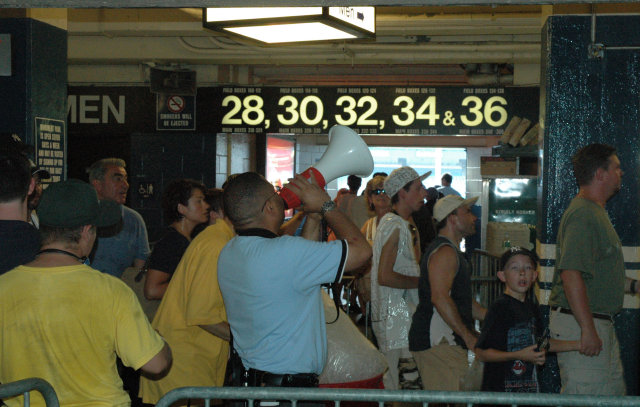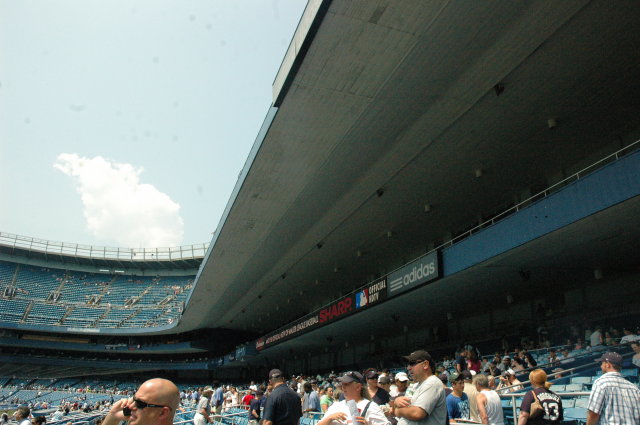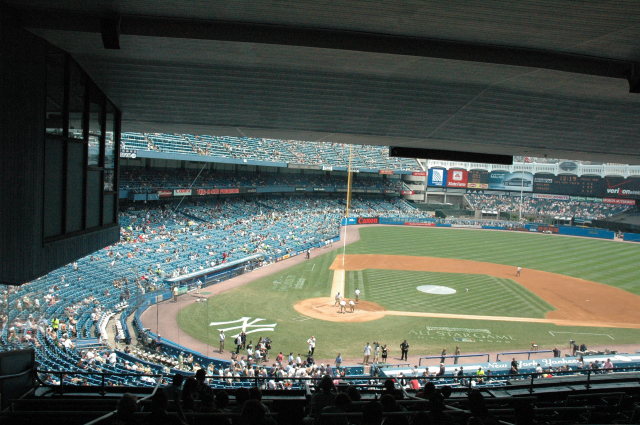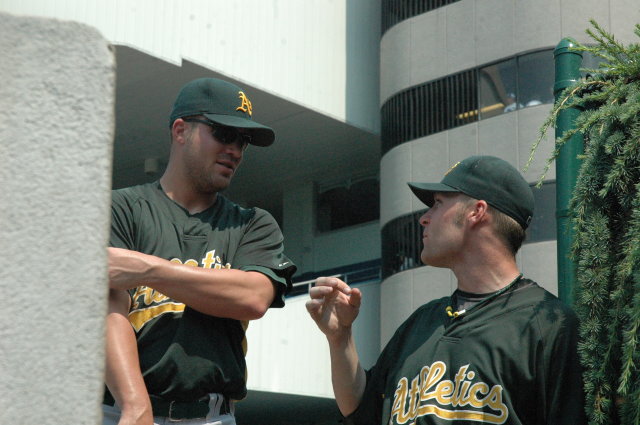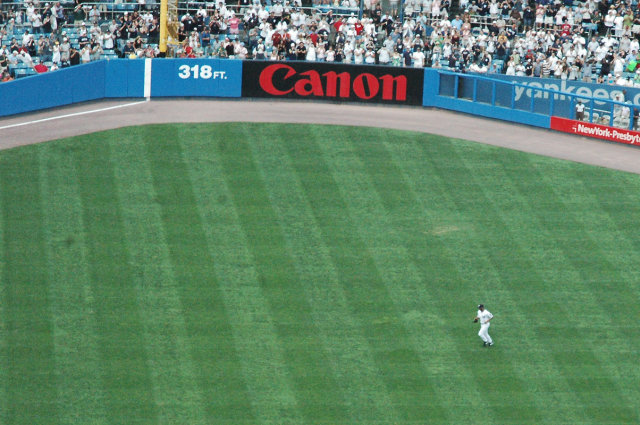Perfect grace consists not in exterior ornamentation of the substance, but in the simple fitness of its form.
All forms of great artistic expression are paradoxes at their core. Each work of art must have some sort of underlying unifying principle. To succeed, the elements of that artwork have to both connect with that underlying principle in order for the work to cohere, and at the same defy that principle in order for the work to surprise and delight. Jazz songs, for example, typically start off with a basic melody played straight, off of which the musicians will then improvise for the remainder of the song.
When I visit a new ballpark, I love to start out by finding a place where I can stand and absorb a panorama of the ballpark. What’s this park about? What’s the melody that holds this thing together? Often, this isn’t something you intellectualize–you just get an overall feeling of the place. Once, I’ve got that sense, I like to go around and photograph all the little elements of the park that surprise and delight me.
Last Sunday, I made my first and only lifetime visit to Yankee Stadium. My usual modus operandi was thrown off from the start, as I was informed by Cliff Corcoran that if I want to see Monument Park, I should go straight there as soon as the gates open, or I won’t get in to see it at all. So my first impression of Yankee Stadium was not a panorama, but a crowded throng of humanity being led by ushers with bullhorns up and down and around and through narrow, low-ceiling ramps and barricaded corridors in a 95-degree heat:
It reminded me a bit of trying to see the Mona Lisa in the Louvre. Perhaps it is a great work of art, but it’s hard to make much of a connection to the artwork itself when your emotions are all caught up in having to swim through the overwhelming crowds just to get a glimpse at thing. There’s no time for contemplation and reflection, you’re just being rushed through the checklist. OK, here’s your monuments. Lou Gehrig? Check. Babe Ruth? Check. Joe DiMaggio? Check. Ok, next! Keep it moving, folks…
Perhaps, though, this is the appropriate introduction to Yankee Stadium. For whatever assets Yankee Stadium has, it’s important to remember that it’s the people who lie at the heart of it. Not so much for the people like Ruth and Mantle and Jeter and Rivera (although that’s certainly part of it), but the 20 million or so people who jam themselves into this small corner of the earth and who for 85 years have funneled themselves into this building to pass on from one generation to the next a cultural and communal tradition, and to pass on to the Yankees’ franchise an economic perpetual motion engine to drive its success.
This history–not of flags, but of families–is what separates the Yankees from my team, the Oakland A’s. There were kids at that game whose parents and grandparents and great-grandparents had all come to that same spot as kids to eat hot dogs and peanuts and Cracker Jack, to sit in the same seats and watch the same team playing the same game. It’s a continuous, unbroken line to the past.
Meanwhile, the generation before mine in Oakland didn’t have a major league team at all, and the team we now have has called three different cities home and is planning to move again. For a century, every time the A’s have had success, the players who generated that success have been sold off. Even the signature player of Oakland Athletics history, hometown product Rickey Henderson, left the team and returned four times. The product the A’s sell is inferior because the experience lacks the emotional connection created by continuity and loyalty and tradition.
Did I just praise Yankee fans? Why, yes, I did. Like my Fenway Park experience two years ago, I found my Yankee Stadium experience much more wholesome and family-friendly than Red Sox and Yankee games at the Oakland Coliseum. The obnoxious in-your-face bandwagon jumpers who show up at Yankee and Red Sox road games deserve to rot in the lowest circles of hell, as far as I’m concerned. But my encounters with the home town fans in both cities were universally pleasant and welcoming.
The atmosphere of history at Yankee Stadium is discussed so often it has become cliche. But Yankee Stadium isn’t just a historical artifact, it’s a work of architecture. After I finally extricated myself from long queues through Monument Park, I wanted to to take a breath, look around a bit, to pause and reflect and absorb the nature of the building.
In most of the ballparks I’ve walked through–Fenway Park, Tiger Stadium, Petco Park, AT&T Park and Dodger Stadium come to mind–I’ll find myself turning this corner or that, and finding some interesting angles or structure or views to look at or contemplate or photograph. Yankee Stadium, I quickly found, is curiously lacking in any such interesting nooks and crannies. This photo, I think sums up why that is:
The architects of Yankee Stadium took the complex problem of arranging so many spectators around the odd shape of a baseball field, and gave the form a very simple solution. The seating bowls along each foul line do not curve at all. They’re arranged in two long straight lines, which meet at a very sharp curve behind home plate. It’s a surprisingly minimalistic design for a city as busy and complex as New York.
That curve where the two long lines meet give Yankee Stadium it’s signature shape, the long area behind home plate which sticks out as distinctively as Jay Leno’s chin:
The “chin” is the best sort of ballpark quirk: something surprising that arises naturally out of the architectural theme. The straight-line seating bowl may not otherwise give many interesting opportunites for amateur photographers (a problem the nearly circular Oakland Coliseum also has), but the unusual backstop area tells us very clearly: this not just a ballpark, it’s a Stadium. Our nooks and crannies, our problems and solutions, simply operate on a larger scale.
Perhaps this is part of the reason why Yankee Stadium often rates a “meh” from visitors. The simple elegance of the seating bowl is not the type of thing that surprises you over and over again. You may be struck by and appreciate its beauty the first time you see it, but then you quickly get used to it, and forget about it. The beauty is on a scale larger than the human eye is used to contemplating. And the elements of the ballpark that operate on a human scale, like the concourses, are quite bland and featureless when they’re not noisy and crowded.
A bigger problem in my mind, however, is that the minimalistic theme of the main seating bowl is betrayed by the mess that exists beyond the outfield fence. Kansas City has a minimalist seating bowl, too, but they carry the minimalist theme all the way around the outfield. At Yankee Stadium, however, the minimalism stops just beyond the foul poles. The outfield bleachers don’t come all the way down to the fences, Monument Park is split into two sections, and interrupted inbetween by bullpens. In fact, when I was in line between the two sections, Greg Smith and Joey Devine wanted to leave the A’s bullpen and return to the dugout, and had to cut through our line right in front of us to get back on the field.
Now this sort of thing might be cute in a park-o’-quirks like Fenway, but in an otherwise minimalist structure like Yankee Stadium, it’s just incoherent. How many different building materials can you spot in this picture? There’s concrete, wood panels, a glass window, a chain link fence covered with some sort of evergreen plant, whatever the heck the facade of that beige building made out of–stucco?–plus some sort of iron grilles and tinted plexiglass windows. Not visible in the photo are the clear plexiglass of the outfield wall and a rope netting to the left, and red bricks ahead to the right. There’s no rhyme or reason why the outfield fences or anything behind them are where they are and made of what they’re made of. There’s no form that these structures fit into, nothing neatly arranged as simply as possible. It’s just a hodgepodge of stuff, stuffed behind a fence, like a pile of toys you threw into your closet when your mom told you to clean your room.
The good news is that New Yankee Stadium will fix the outfield, so that the pieces will all fit together in a much more orderly fashion. The bad news is that they didn’t keep much of the old minimalist structure in the main seating bowl. The new upper decks bend around the field instead of forging straight ahead down the foul lines, and without the straight line structure, the sharp curve that forms the signature backstop area also disappears. They’re removing both the best and worst features of the old Yankee Stadium. The new Stadium will be just like the old Stadium, only smoothed out–more luxurious, but less elegant.
Here, it’s important to remember our original theme, that Yankee Stadium is about people. Whether the new park works better than the old one will be decided by the people who go there. Will families be able to afford the new luxurious seats, to pass on the traditions to further generations? Or will Yankee Stadium become the exclusive realm of corporate fatcats yapping on cellphones? Will the fans still buzz at every mention of Derek Jeter’s name?
The fans will make or break the new park, just as they made the old one. Despite my disdain for the architecture of the bullpen area, and despite the fact that I was rooting for the visiting team, I have to admit I got a thrill out of the growing buzz in the crowd as Mariano Rivera walked out of the bullpen and jogged across the outfield toward the pitcher’s mound to close out the game. At that moment, there’s no building in anyone’s mind, there’s no architecture–just a great player stepping onto a big green baseball field, and 50,000 people expressing their love.



